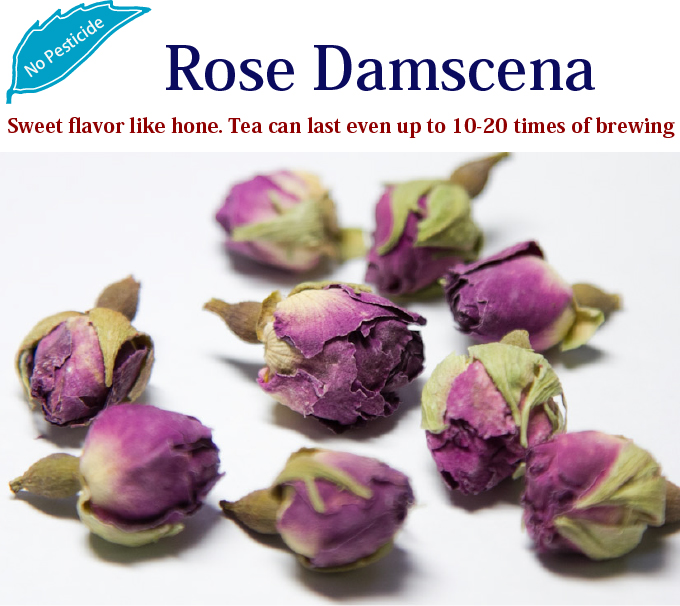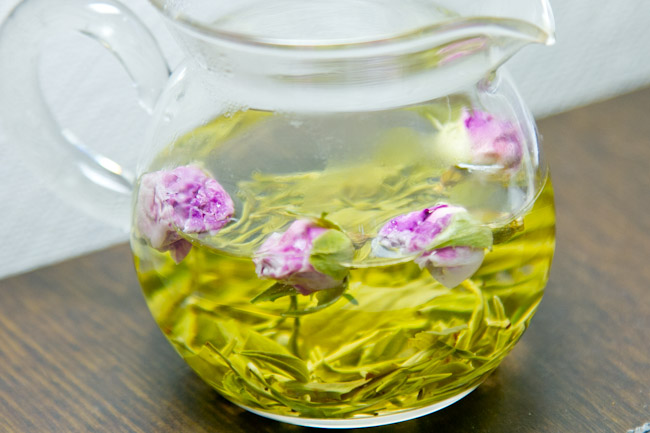
Thank you for visiting HOJO website. If you have any enquiry, please feel free to get in touch with us at
▼ Akira Hojo
▼ Hojo Newsletter
▼ HOJO FACEBOOK





HOME > Flower Tea>Rose Damascena

I assumed that many people has ever tried rose tea. For me, the ordinary rose tea's flavor reminiscent the flavor of cinnamon or pickles. Honestly, I did not enjoy the aroma of ordinary rose, therefore till now I didn't introduce it.
Few years ago I tried the Rose Damascena essential oil at the cosmetic counter. It gave sweet aroma like honey. When I first tried the Rose Damascena tea, I was shocked by its flavor. Its aroma is completely different from the ordinary rose that I knew before. This Rose Damascena tea gives a sweet aroma like honey with a fruity note.
The renowned production area of the Rose Damascena is in Bulgaria, Turkey or Iran. However this rose also exists in China. It is grown in desert of Xinjiang. A long time ago, roses through the Silk Road was brought to Xinjiang. Rose Damascena was planted by the local ethnic minorities in Xinjiang. The outlooks and the language of these minorities is very similar to that of Turks indeed. In desert climate, the temperature gap between daytime and nighttime is very huge. Roses grown under this environment are very rich in the substances that contributes to its unique flavor.
It is very simple to brew: all you need is just a few pieces of rose, place it in a teapot or a teacup and then pour in 100 to 200 ml of boiling water. It can lasts for more than 10-20 brewing. If you wish to discontinue brewing, you can keep roses in the refrigerator and then later continue the brewing. The flavor of the rose is very stable.

One of my favorite way to enjoy Rose Damascena is to blend it with other tea. In particular, I like to blend Rose Damascena with green tea or white tea. I do not like to use too many roses, because the scent of rose is too strong and it will overshadowed the taste of tea. For green tea, I normally use two pieces of rose. I prefer to keep the flavor of the rose in the background. I prefer to let the aroma of roses as a foil rather than to do as the lead.
Sometimes, I like to blend rose with raw pu-erh tea. Generally rose has less body and aftertaste. Combining the rose with raw pu-erh enhances the overall drinking experience.

In you are using tap water, it is necessary to filter the water using an activated carbon filter. If not, you wouldn’t be able to enjoy the authentic taste of tea. Chlorine is added to tap water in order to sanitize bacteria. This chlorinated water will also harm our body cells. Concerning about our health condition, it is very important to remove chlorine from drinking water. The most effective method in removing chlorine is to install an activated carbon filter. This type of filter is designed for removing organic substance. It will remove not only chlorine, but also other harmful substance such as contaminated pesticide. The activated carbon filter can be easily obtained from the common hardware shop in most countries. If activated carbon filter is not available, please place a charcoal inside the water and leave it for over night. The material composed of activated carbon filter is made of ground charcoal. The difference is that activated carbon filter contains much finer particles and hence it has extremely large surface area for a better efficiency in filtration. We do not suggest RO water (reversed osmosis water) or distilled water. This water carries no mineral, the taste and flavor of tea tends to be very unstable, unless you have very superior quality tea and tea equipment.
In the long run, you may observe a thick layer of scale accumulated inside your kettle. Our mother usually taught us to wash and remove it with citric acid. But please do not even try to remove the scale. Scale consists of minerals that exist in the water. The mineral composition is reflected from the water you used. If you remove the scale, the mineral ion balance between scale and water is destroyed. This balance is called buffer effect in science. The flavor and taste will seriously run out and you won’t be able to get previous taste and flavor for a long time. It is also important to stick to the same type of water whenever brewing tea. If source of water is changed, it carries different type of minerals. It will affect the mineral ion balance too.
Go to further information about suitable water for brewing tea >>
You need about 6 pieces of rose flower in 200ml of water.
Use boiling water
Time for infusion is about 30 seconds. For the 2nd brewing onwards, keep each brewing less than a few second. The rose is very stable taht you can brew even up to 20 times. If you need to stop on the half way, please keep the tea in a fridge so that you can resume when you are back later.
Once a bag of tea is opened, please finish it within 3 months if you wish to enjoy its freshness. From the medical point of view, it is safe to consume the tea even if it is kept for a few years. However the freshness disappears if it is kept for too long. Tea must be tightly sealed before it is kept. Tea should be kept in ambient and dry conditions such as in the living room, but it must be completely away from humidity. Tea should not be kept in the kitchen as the environment is very humid. Avoid enclosed area such as inside the cupboard or drawer as these places are damp. Also avoid opening the bag of tea in humid atmosphere. It is recommended to open the bag during a sunny day or under air-conditioned atmosphere. Once tea leaves absorb moisture, deterioration of tea will be triggered within a few days. Tea will then give an astringent taste, sometime it tastes sour. The fresh aroma also becomes weaker.
The quality of tea lasts longer if it is kept in the fridge. However we strongly recommend you not to keep tea in the fridge. When tea is withdrawn from the fridge, there is usually condensation. Once tea is exposed to moisture during condensation, the quality will deteriorate within a few days. The higher moisture content in the tea leaves will trigger oxidation and it will completely destroy the quality of tea.
Here’s one frequently asked question: what happens if bag is sealed using tape or tea is packed in zipper bag and kept inside the fridge?
For your information, these simple sealing methods are not sufficient. When the bag is withdrawn from the fridge, it is cold inside the bag and therefore causes negative pressure. Air will be drawn from outside and condensation will occur. In addition, if the bag is taken in and out from the fridge very often, this will cause heat stress to the tea leaves as temperature is increased and decreased very frequently. If tea is kept in the fridge, when it is withdrawn from the fridge, it is necessary to leave it in ambient atmosphere for more than 24 hours in order to warm up the tea leaves. Based on our experience, 12 hours is not long enough. We may think tea is warmed up, but inside the bag, the tea leaves are still cold due to insulation effect.

Please feel free to send us e-mail for enquiry at:

 |
We accept various kinds of credit card through Paypal.
Only if customer prefer other option of payment, we suggest "Bank Transfer".
Various choice of shipping method
EMS, SAL, Small Packet, Small Packet (SAL) Yamato Express and Surface
For shipping tea, we usually suggest small air parcel, the estimated shipping cost of tea in 100g (with wrapping material ) is
Small Parcel
USA JPY 600, EU JPY600 and Asia JPY470
Small Packet (SAL)
USA JPY380, EU JPY380 and Asia JPY320
The shipping fee to oversea by small air parcel happens to be even cheaper than domestic shipping fee in Japan.
For your information, some countries, EU in particular imposes custom duty. We need buyer to bare the duty. We are sorry, but we cannot change the amount on the invoice, and we do not mark any packages as gifts. We will strictly follow the custom regulation.